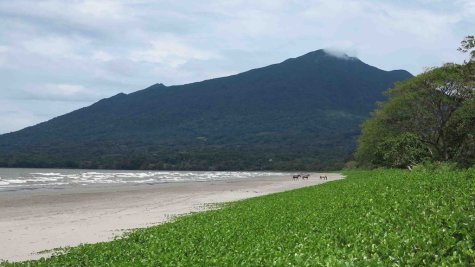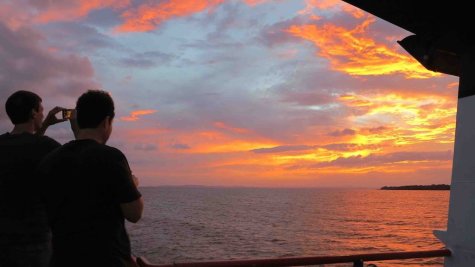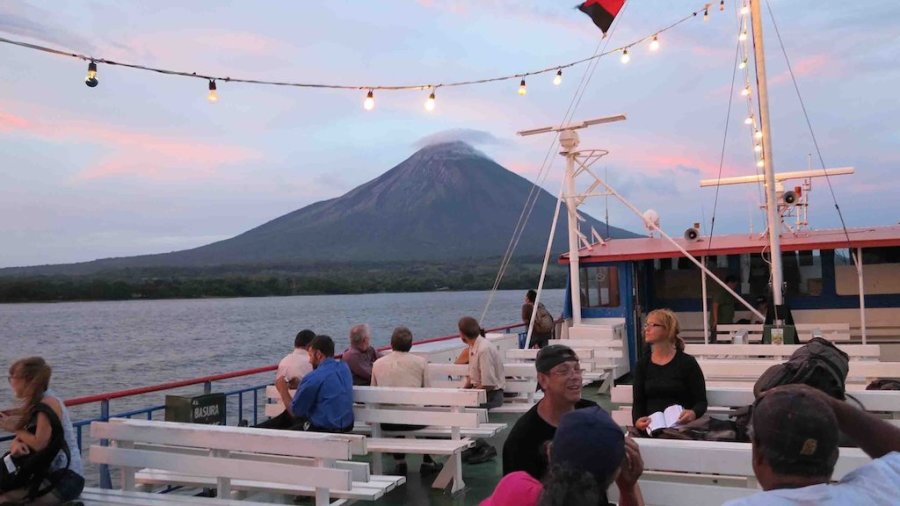On Lake Nicaragua’s Adventure Isle, Twin Volcanoes Play Host
The Concepcion Volcano looms in the background as a ferry approaches Nicaragua’s Ometepe Island on August 12, 2014. The island is a paradise for adventurers and nature lovers
November 25, 2014
By Tim Johnson
OMETEPE ISLAND, Nicaragua — Gaze eastward from the shores of huge Lake Nicaragua, and they seem almost like a mirage: Twin volcanoes thrusting out of the water, one of them a towering cone of cinder and ash, the other jacketed in verdant jungle.
Perhaps it was the clouds that shrouded the twin peaks. Or the majestic sunset behind our ferryboat. Whatever, as we approached on a late afternoon the setting seemed primordial, a place of mystery and beauty with a dash of menace.
In fact, land girdles both volcanoes, terrestrial tutus on a pair of giant dancers. A small isthmus connects the skirts, uniting the giant peaks to form Ometepe Island, one of the Western Hemisphere’s least recognized adventure destinations.
The island is just becoming known to travelers for its hidden petroglyphs, deserted beaches and eco-lodges, where one can kayak and cycle, all in the shadow of the two looming volcanoes.
Surrounding the island is one of Latin America’s larger inland seas. Lake Nicaragua is comparable in size to Lake Titicaca, the Andean body of water along the border of Peru and Bolivia. Even from atop one of Ometepe’s volcanoes, it’s hard to see land across the expanse of the lake.
Explorers have marveled at Ometepe’s beauty for centuries, including Mark Twain, who wrote in 1867 of the “two magnificent pyramids, clad in the softest and richest green, all flecked with shadow and sunshine.”
Around the same time, German geologist Karl von Seebach felt nearly speechless upon beholding the volcanoes: “No words, nor drawings, can ever describe this marvelous spectacle of nature.”
The island gets its name from the indigenous Nahuatl language, and means the place of two mountains, referring to the Concepcion and Maderas volcanoes. Concepcion, the larger of the two, is still active. Its cone towers 5,282 feet, and wispy white gases from its vents, known as fumaroles, curl above its peak.
After several days on the island, four of us decided to test our mettle and climb the smaller of the two volcanoes, Maderas, elevation 4,570 feet.
We hired two guides at the Finca Magdalena, a cooperative coffee farm and the trail head for one of three paths that lead to Maderas’ crater. But when a supervisor looked at my sport sandals, he shook his head. The trail is rocky and muddy, the climb arduous. Don’t attempt the nine-hour hike in sandals, he said.
My 17-year-old daughter and I decided to go halfway, returning with one of the guides. Our hiking companions, a fellow foreign correspondent and her 24-year-old daughter, would attempt the whole climb.
It was just 20 minutes or so into the hike, after we’d entered primary forest, when the bellow reached us from a distant ridge. It sounded antediluvian, deep and scary.
Not to worry, our guide said, chuckling a bit. It was just some howler monkeys. We would later see several of the monkeys resting on high branches.
After hours of rigorous hiking, much of it over fallen tree trunks, and up the increasingly steep rock-strewn trail, we reached a clearing: the halfway point.
The brisk wind kicked up whitecaps in the lake water lashing the isthmus at Playa Santo Domingo far below. By this point, my weary daughter was delighted to turn around. We said our goodbyes, and watched our friends head up the trail, led by the other guide.
After nine hours, our friends still hadn’t returned to Finca Magdalena, and we began to worry. An hour later, they sauntered down the trail, wet and bedraggled. They’d climbed to the crater rim with the guide, and attempted to descend to a lake in the crater, but cloud and mist shrouded everything. An avid jogger, our friend said the climb was harder than a half marathon she’d run months before.

Nicaragua’s Tourism Institute has some words for those who’d like to climb either of the volcanoes: Hire a guide, stay on the path, take food and water, and bring warmer clothing for higher altitudes. In 2004, rescuers found the bodies of two hikers, British and American, at the bottom of a ravine on Maderas. They’d gone without a guide, got lost and tried to find their way at night, plunging to their deaths.
Everyone in our party survived, though, and it was time to explore other parts of the island. There was much to do. One can ride along the beach on horses for about $6 an hour. We chose to visit an aquatic playground, called el Ojo del Agua, or the Water’s Eye. Along the isthmus between the volcanoes, the site collects clear water from springs into a crystalline swimming hole, popular with travelers.
One can arc into the water on a rope swing, or sunbathe and sip coconut milk.
The pre-Columbian past of Ometepe is rich. Stone statues, urns and ceramic vessels have been found all over the island, remnants of cultures dating to 1000 B.C. On another day, we visited El Ceibo Museum near the town of Moyogalpa, a repository of some 1,200 archaeological pieces, including big funerary vessels.
There was plenty of time to laze at our beach-side hotel. One day, I chatted with one of the owners, Ramon Castillo Monge, a biologist and Ometepe native.
“Tourism really started about 20 years ago,” he said, adding that 60 or 70 small hotels, restaurants and other facilities cater to tourists these days.
Castillo recited from a mental list all the things to do on Ometepe: “The island has white sand beaches, black sand beaches, water that is both serene and rough, where you can practice kite surfing. You can climb volcanoes, and explore farms. You can see petroglyphs, and look at migratory birds.”
Seeking to promote tourism on Ometepe Island, which was declared a biosphere reserve by a United Nations body in 2010, the Nicaraguan government inaugurated a $12 million airport with a 4,900-foot airstrip last May. A domestic carrier, La Costena, flies twice a week from Managua, the capital.
“It is a new destination for people coming from outside the Central America region,” said Javier Chamorro, the head of ProNicaragua, an export and investment promotion agency in the capital. “It is the only island in fresh water that you’ll find with two volcanoes.”
Just how long Ometepe might endure in its present form is a matter of some anxiety on the island. In mid-2013, President Daniel Ortega announced an audacious plan to challenge the monopoly of the Panama Canal by building a $50 billion transoceanic waterway that would allow mammoth ships to cross Nicaragua between the Atlantic and Pacific oceans. The proposed route cuts across Lake Nicaragua, just to the south of Ometepe Island.
Whether Ortega and the Hong Kong-based company that won a 50-year concession to build and operate the canal can get financing and begin digging the massive project is yet to be seen.
The potential impact on tourism could be great. Instead of coming to see natural wonders, tourists might arrive to observe the passage of huge bulk carriers, container vessels and supertankers. Larger hotels may sprout up.
Castillo, the small-hotel owner, is downcast about the canal proposal.
“I don’t think they will build it,” he said. “In the remote case that it is built, it might create a false illusion of economic growth.”
In the meantime, he said he hoped that tourists awakened to Ometepe’s charms and that investors in restaurants and hotels improved their offerings, bringing higher-spending — but not necessarily more — tourists.

©2014 McClatchy Washington Bureau
Visit the McClatchy Washington Bureau at www.mcclatchydc.com
Distributed by MCT Information Services















